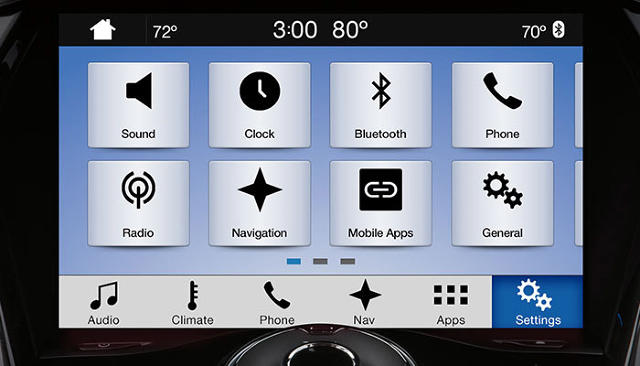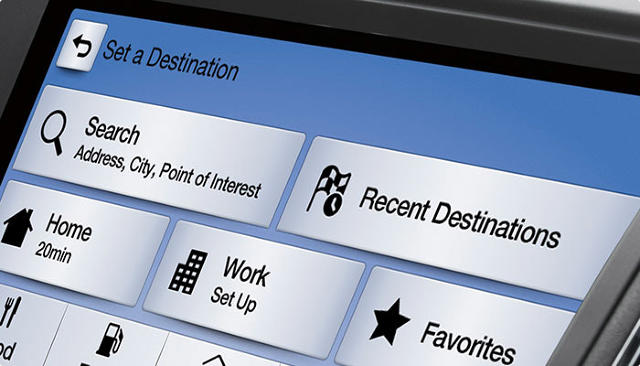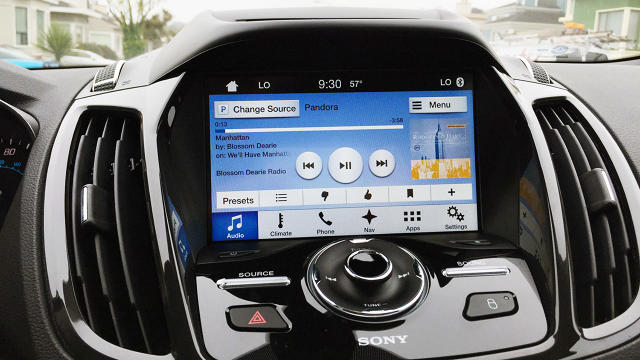Hands On With Sync 3: Ford Gets Its Connected-Car Mojo Back
After years of partnership with Microsoft, the carmaker is ditching its glitchy old platform for a markedly slicker system.
When I had the opportunity to try out Sync 3, Ford’s new in-car information and entertainment system, there was one thing I was hoping for above all else: I wanted it to just work.
My outlook was shaped by the experience of owning a Ford car with Sync’s predecessor, MyFord Touch. Though it can do many things, MyFord Touch rates about a C- on the usability scale. Even just getting it to register the correct input when you touch the screen is an ongoing challenge, and the software is still bug-ridden, five years after the first version shipped.
MyFord Touch is far from the only quirky car infotainment system out there, but it’s such a mess that it wasn’t a shocker when Ford announced it was dumping the Windows-based platform it had used since 2007 in favor of QNX, the BlackBerry-owned operating system that dominates the connected-car business. Based on the 10 hours or so I recently spent tooling around in a 2016 Ford Escape equipped with a preproduction version of Sync 3, that was the right move: The new system is much better than the one it replaces, in all the ways that matter most.
The 2016 Ford Escape and Fiesta are getting Sync 3 this summer. MyFord Touch will linger on in some models until the end of next year, when Ford expects to have rolled out the new system across the Ford and Lincoln lines.

Different, Only The Same
Despite having entirely different technical underpinnings, Sync 3 is more identifiable as an evolution of the MyFord Touch experience than I expected. The existing voice commands work; the capabilities it offers in its sections for music playback, navigation, and other tasks haven’t changed all that much; the supplementary screen nestled between the tachometer and odometer remains exactly the same. Nothing that’s new feels like change for the sake of change. But Ford has addressed almost everything that was irksome about the old system.
That starts with the touch screen. MyFord Touch used a resistive screen—based on an old-school technology akin to what you got on a Treo a decade ago—and did a terrible job with the size and location of buttons. Sync 3 has a capacitive screen, like a modern smartphone, and bigger, better-placed buttons. You can now perform smartphone-style gestures such as swiping your way through a list of destinations in the navigation feature, or pitching and zooming a map. But the best part of the new screen is that I never had to jab repeatedly at it to get it to work, and it never misunderstood which button I was trying to press.
The voice input is also way less of a headache than it is in MyFord Touch. That previous version is reasonably accurate. But it’s so slow that passengers in my car routinely tsk-tsk about the sluggishness when they observe me using it. And it usually can’t figure out the name of a place—such as “Specialty’s Café & Bakery”—unless I phrase it exactly the way that the system has it registered in its database. By contrast, Sync 3 swiftly and accurately interpreted my speech, and was smart enough to know what I meant when I asked for directions to “Specialty’s.”

Sync 3 also just looks nicer than the ATM-like MyFord Touch. It’s crisper and more modern, with a lighter color scheme that’s easier on the eyes. I did have a couple of usability quibbles: The smartphone-like notifications of driving directions that pop up at the top of the screen cover up the current time and the icon that lets you get to the home screen—both of which are the sort of thing that should be present at all times. And the navigation system shows you either the miles to your destination or the estimated remaining time to get there. Why it doesn’t display both at once, like MyFord Touch, I can’t say.
App-Enabled, At Last
Maybe the weirdest thing about MyFord Touch is that it’s never supported AppLink—a five-year-old Ford system for connecting to apps on iPhones and Android smartphones which does work with the company’s earlier, less fancy version of Sync. With Sync 3, AppLink is supported, although developers will need to update their apps for the new system.
I was able to try Spotify, Pandora, and location-sharing service Glympse. You need to be running the apps in question on your phone and, in the case of the iPhone, be connected to the car via a USB cable. But if you are, you can pull up the app on the Sync 3 screen and perform tasks such as choosing an artist in Spotify or sending your location in Glympse.

AppLink is useful, but it’s only supported by a smattering of smartphone apps. Over time, carmaker-specific technologies of its type may be supplanted by Apple and Google’s own systems for car-to-phone connectivity, CarPlay and Android Auto, respectively. When Ford implements those technologies—which it says it’s going to do—it may be a bigger boon for its customers than AppLink has ever been.
Sync 3 does introduce one bit of useful iPhone-specific functionality: hands-free Siri. With your iPhone connected via Bluetooth, holding the voice button in the steering wheel lets you issue Siri commands and queries. I found it handy for purposes such as checking on my schedule without removing my eyes from the road.
Bugs Begone
Is Sync 3 less unreliable than MyFord Touch, which—to give one example—sometimes mysteriously stops giving me driving directions during a journey in progress? I can’t really address that question based on my brief time with the system. I was ready to report that I hadn’t witnessed any peculiar behavior during my test drive with a preproduction version of the software. But then, when I was returning the Escape to Ford, the voice recognition failed to work. Turning the vehicle off long enough for Sync 3 to reboot itself solved the problem.
If Ford does update Sync 3 to squash bugs, getting the fixes should be easier. With MyFord Touch, you need to download updates on a computer, transfer them to a thumb drive, and then plug the drive into a USB port in your vehicle. Sync 3 has built-in Wi-Fi; assuming your car is within range of your home network, Ford says it can update itself automatically and wirelessly.
When Ford released its original, non-touchscreen version of Sync back in 2007, it was very much ahead of its time, in an era when few cars were connected. A lot has changed since then. Sync 3 doesn’t introduce any radically new features of the sort that would put the company back in front of the pack. But if all it does is to perform its tasks quietly, competently, and pleasantly, it will be better for the carmaker’s reputation than MyFord Touch ever was. And my time with it was enough to leave me guardedly optimistic about that happening.
Fast Company , Read Full Story
(170)














